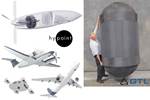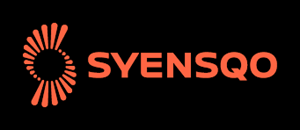New GTL breakthrough in composite tubing for liquid hydrogen in aircraft and space vehicles
Tests versus stainless steel tubing show 10 times faster chill down, fuel flow in 2 seconds and less boil-off for significantly faster fueling and refueling of LH2-powered space vehicles, aircraft and trucks.
Share

GTL’s blended hybrid laminate (BHL) composite tubing and lightweight dewar tank for liquid hydrogen (LH2). Source | Gloyer Taylor Laboratories (GTL)
Gloyer-Taylor Laboratories Inc. (GTL, Tullahoma, Tenn. U.S.), an aerospace engineering research and development company, has announced breakthrough results in its Blended Hybrid Laminate (BHL) composite technology for use with cryogenic liquid hydrogen (LH2) in tubes, pipes and transfer lines. LH2 is a key fuel used for space launchers but is also being developed by Airbus and other aircraft OEMs for zero-emission aviation.
When transferring LH2 from a delivery or storage tank to vehicle tanks, NASA and other entities have reported high losses due to boil-off of the cryogenic liquid to vapor. These losses can be as much as 50-70% of the fuel being transferred, which results in lengthy cooldown times required to avoid such boil-off. This poses significant challenges to repeated refueling as vehicles sit on the launch pad, waiting for final clearance and countdown. Now, results from a NASA SBIR program show that GTL’s composite tubing can reduce this chill-down time and LH2 boil-off, as well as the mass of cryogenic fluid transfer lines.
GTL first developed its BHL technology for cryo-tank applications (see “GTL validates LH2 composite dewar tanks for use in aviation”). However, the innovative materials and process also work well for cryogenic transfer lines, tubes and pipes, providing up to 10 times lower thermal mass than metal tubing. In a recent series of tests, GTL demonstrated the feasibility of these pipes in quickly reaching a temperature of 20°K (-273°C) and beginning the flow of LH2 within 2 seconds. This means that once integrated into operational systems, an aircraft or launch vehicle’s LH2 tanks could be filled in minutes instead of hours and easily manage the small amount of LH2 that is boiled off during fill operations, significantly reducing fuel costs and increasing operational safety.
“We are thrilled with our team’s efforts to test and validate our BHL composite technology and its demonstrated ability to outperform conventional metal transfer lines for both mass and boil-off characteristics,” says GTL president Paul Gloyer. “We first had strong results with our composite LH2 tank technology and now we have tubes that demonstrate fast fill and refill capabilities. The ultra-lightweight BHL technology being used/validated in this effort marks another key milestone in our efforts to advance hydrogen-powered innovation and vehicles.”
Looking closer at the results, the SBIR effort tested a series of lightweight BHL composite tubes along with equivalent metal tubing. These tests confirmed and validated the enhanced thermal properties of BHL tubes and demonstrated that they chilled down approximately 10 times faster than equivalent stainless steel tubing. The combination of a reduction in thermal mass and enhanced heat transfer properties achieved this improvement. With this technology, LH2 boil-off during fuel transfer can be significantly reduced, opening the door to practical no-vent filling of LH2 tanks for aircraft, trucks and spacecraft.
This SBIR Phase II effort also verified the scalability of the BHL tubes and demonstrated the capability to:
- Produce tubes with a range of diameters and lengths.
- Create tube bends and accommodate tube flexure.
As part of the effort, GTL fabricated flight-capable BHL tubing as the main liquid oxygen (LOX) and liquid methane (LCH4) propellant lines for GTL’s Disruptor suborbital rocket, which successfully demonstrated a cold-flow ground test of the vehicle.
GTL has multiple concurrent projects that leverage BHL technology, including integration of BHL composite tubing into the flight prototype of GTL’s ultra-lightweight composite LH2 vacuum and jacketed dewar tank, scheduled for flight testing on a manned helicopter in Q4 2024. In the coming year, BHL tubes will also be integrated into further flight applications, demonstrating their lightweight, high-performance capabilities. GTL intends to integrate BHL tubes into future vehicle designs and cryogenic transfer line solutions. Its BHL composite technology applies to nearly any cryogenic system and thus offers benefits to space launch and satellite systems as well as lunar, cislunar and Mars mission applications.
Related Content
Microwave heating for more sustainable carbon fiber
Skeptics say it won’t work — Osaka-based Microwave Chemical Co. says it already has — and continues to advance its simulation-based technology to slash energy use and emissions in manufacturing.
Read MoreCryo-compressed hydrogen, the best solution for storage and refueling stations?
Cryomotive’s CRYOGAS solution claims the highest storage density, lowest refueling cost and widest operating range without H2 losses while using one-fifth the carbon fiber required in compressed gas tanks.
Read MoreSyensqo becomes new Solvay specialty materials company
Syensqo represents what was Solvay Composite Materials, focused on delivering disruptive material technologies and supporting growing customer needs.
Read MoreRecycling end-of-life composite parts: New methods, markets
From infrastructure solutions to consumer products, Polish recycler Anmet and Netherlands-based researchers are developing new methods for repurposing wind turbine blades and other composite parts.
Read MoreRead Next
ZeroAvia advances to certify ZA600 in 2025, launch ZA2000 with liquid hydrogen in 2027
Lightweight composite tanks are key to ZeroAvia’s vision for H2 aircraft to rival range and utility of jet fuel aviation.
Read MoreHyPoint partners with GTL to extend zero-emission flight with ultralight liquid hydrogen tanks
NASA award-winning fuel cell pioneer works with carbon fiber tank maker GTL to offer up to 10 times more capacity versus existing hydrogen storage tanks.
Read MoreGTL validates LH2 composite dewar tanks for use in aviation
Test results exceeded expectations regarding holding hard vacuum, heat load, rapid chill-down and hydrogen fraction goal, leading to flight prototype fabrication.
Read More























